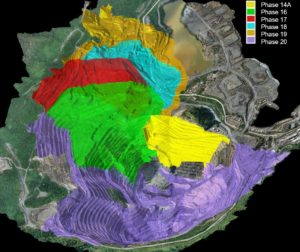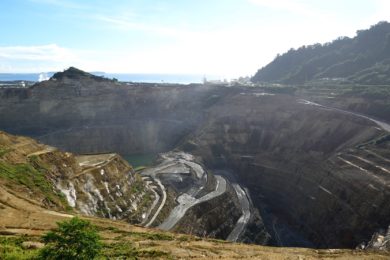Newcrest Mining Ltd has announced that the Newcrest Board has approved the Lihir Phase 14A Pre-Feasibility Study (the Phase 14A Study), enabling the commencement of the Feasibility Study and Early Works Program. The Study focuses on extending the Phase 14 cutback and safely steepening the walls of the pit utilising civil engineering techniques to access existing Indicated Mineral Resources that would have otherwise been inaccessible through standard mining techniques. The Study integrates Phase 14A’s future mine design and sequence into Lihir’s mine plan and establishes the expected costs, schedule and sustainable production rate.
Newcrest Managing Director and Chief Executive Officer, Sandeep Biswas, said: “The findings of our Lihir Phase 14A Pre-Feasibility Study accelerate the realisation of our aspiration for Lihir to be a 1 million ounce plus per annum producer from FY24, which will benefit landowners, all Lihirians and PNG. Phase 14A increases Lihir’s Ore Reserves, brings forward gold production and improves operational flexibility by establishing an additional independent ore source. The Study also highlights the opportunity for Phase14A techniques to be applied to future cutbacks at Lihir, potentially unlocking more value. We have also confirmed the deferral of the need for the Seepage Barrier to Q2 FY26, with the potential to further defer the timing of the barrier.”
The Phase 14A Study has identified the following:
- Estimated project capital expenditure of A$179 million
- Internal Rate of Return (IRR) of 37% (real, after tax)
- Payback of 2.6 years
- Net Present Value (NPV) of A$284 million
- Mill feed increase of 483,000 oz contained gold, with ~400,000 oz of additional gold produced from FY23 to FY26
- Additional Life of Mine (LOM) gold production of 965,000 oz
The Feasibility Study is expected to be completed in the fourth quarter of FY22, with the expenditures and study scope expected to include early works expenditure of A$47 million for fleet procurement and initial bench establishment; trial works for ground support anchors to validate design, costs and schedule; and additional drilling and test work to validate ore deposit knowledge.
The Lihir Ore Reserves estimate has been updated to include the conversion of the Phase 14A Indicated Mineral Resource to Probable Ore Reserves, increasing Lihir’s Total Ore Reserves by 1 Moz to 23 Moz as at 30 June 2021.
Mining of Phase 14A is expected to take place between FY22 and FY26. Ore mined from this Phase will replace lower grade ore feed to the processing plant, with an initial 13 Mt of high and medium grade ore from Phase 14A planned to be fed between FY22 and FY26. Lower grade material will be stockpiled and fed progressively over the remaining LOM. This is expected to deliver an additional 965,000 oz of gold production over the LOM.
In addition, Newcrest has completed its Seepage Barrier Feasibility Study, which enables further definition of the expected construction costs and schedule. The findings from the project field trials indicate that the Seepage Barrier can be constructed using hydromill cutters and grouting methods. Approval of the Seepage Barrier Feasibility Study to move to Execution has been deferred until FY23, in line with the findings of the Lihir Mine Optimisation Study (LMOS) which established that the eastern limits of Phases 16 and 17 could be moved further east, deferring the need for the Seepage Barrier by ~18 months to Q2 FY26.
In February 2021, Newcrest announced the findings of the LMOS which included the identification of a new, essentially brownfield opportunity called Phase 14A. The Phase 14A Study focused on extending the Phase 14 cutback and safely steepening the walls of the pit by utilising civil engineering techniques to access existing Indicated Mineral Resources which would have otherwise been inaccessible through standard mining techniques. The Phase 14A cutback is expected to provide an additional mining front enabling further flexibility for fresh competent ore feed. The Phase 14A cutback is fully permitted and is within the existing mine lease.
Field trials of the wall support technology are planned for the December 2021 quarter, with long lead materials to be ordered and the engagement of specialist contractors in progress. The addition of Phase 14A into the Lihir mine plan accelerates Newcrest’s aspiration for Lihir to be a 1 Moz+ per annum producer from FY24.
Mining of Phase 14A is expected to take place from FY22 to FY26 and include:
- Total ex-pit mining of 34 Mt, including 13 Mt of high and medium grade ore at an average of 3 g/t, which will displace lower grade ore (mostly stockpile) that would otherwise have been processed in the mill
- An uplift in the total mill feed grade and an additional 483,000 oz of gold in feed and 400,000 oz recovered gold over FY23-FY26
- Backfilling the cutback will occur after the completion of mining and will act as a buttress supporting long-term stability of the highwall.
A program of infill resource definition drilling and trial installations of the ground anchors is underway and will be completed in FY22. This program is expected to improve resource definition, further reducing project risk. The Phase 14A design utilises civil engineering techniques, in conjunction with existing mining practices, to increase pit wall angles. The upper argillic horizons without ground support typically have an unsupported slope angle of ~45° which has been increased to ~77° using soil anchors to provide stability. The soil anchors will be installed in the upper benches of the cutback to support the steeper wall angles in these areas. The slope angles of the lower benches will be similar to the existing walls in Phase 14. The increase in pit wall angle enables access to ore within the current permitted pit shell.

To integrate with the civil construction, mining will be conducted by a dedicated mining fleet which will comprise a small excavator and dump trucks mining 3 m flitches. The 3 m flitches are required to provide a working platform for installation of soil anchors at 3 m vertical spacings.
The Lihir base case gold production schedule projects mining rates to increase up to 50 Mt/y over the coming years and an average milling rate of 15.5 Mt/y. Ore from Phase 14A is expected to be mined between FY22-26 and will be processed over the LOM.
Mining rates for Lihir are expected to increase (as identified in the LMOS) over the coming years through a combination of equipment capacity and mining efficiency projects. Additional mining capacity is expected to be delivered through increased truck availability as a result of a program of truck re-builds and the replacement of primary dig units. This program is currently underway and is scheduled to be completed by December 2021.
Mine efficiency improvements identified in the Study include improved fleet utilisation, which is expected to be achieved by increasing operator availability and improving dispatch tactics to reduce equipment delays. Newcrest is currently implementing numerous throughput improvement initiatives which are targeting the achievement of a process plant throughput rate of 15.5 Mt/y from FY24. Lihir has previously demonstrated annualised milling performance rates of ~16Mtpa during Q4 FY18 and Q4 FY19.
Recovery improvements are expected to be achieved through a combination of increasing mill feed grades, improved feed blends and recovery improvement projects that are currently in progress. Phase 14A is expected to provide additional fresh ore to the mill, offsetting lower grade and lower performing recovery material types. The Front End Recovery project is expected to deliver increased recoveries from the beginning of FY23, with further studies assessing recovery improvements underway.
Current mining activity at Lihir is via conventional truck and shovel operation, with offshore barge disposal of waste rock and land based and in-pit stockpiling and reclaim of lower grade ore. Ore processing at Lihir involves the main operations of crushing, grinding, flotation, pressure oxidation, leaching and electrowinning to recover gold from relatively high-grade sulphide feed producing gold doré. The Lihir process plant utilises proven technology that is widely used in the gold industry for this style of mineralisation. The ore processing facility has been operating since it was commissioned in 1996 and upgrades took place during 2011 and 2012. Comminution circuit operating optimisations and minor upgrades are planned to achieve a 15.5 Mt/y plant capacity










